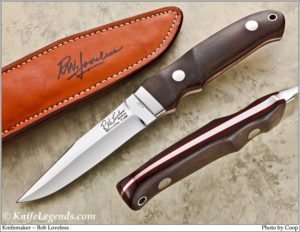 Robert Waldorf Loveless (January 2, 1929 – September 2, 2010), known by the aliases Bob Loveless and RW Loveless, was an American knifemaker who developed hollowground drop point blades and full tapered tangs, along with screw-type handle scale fasteners, within the art of knifemaking. His custom knives are cited by other knifemakers and collectors as being among the most innovative in the world.
Robert Waldorf Loveless (January 2, 1929 – September 2, 2010), known by the aliases Bob Loveless and RW Loveless, was an American knifemaker who developed hollowground drop point blades and full tapered tangs, along with screw-type handle scale fasteners, within the art of knifemaking. His custom knives are cited by other knifemakers and collectors as being among the most innovative in the world.
Loveless was born in Warren, Ohio, on January 2, 1929. When he was 14 years old, he altered his birth certificate and joined the Merchant Marine. Later, he served as an Air Corps control tower operator on Iwo Jima. He was exposed to a number of knife fights in the bars of foreign ports which he attributed to his interest in knives.
After graduating from Chicago’s Armor Institute of Technology (later known as Illinois Institute of Technology – IIT) in 1950, Loveless took a course taught by Ludwig Mies van der Rohe. He returned to Ohio in 1951 to study literature and sociology at Kent State University.
Loveless returned to the Merchant Marine in December 1953 and was assigned to a tanker based in New York. In New York City, Loveless visited Abercrombie & Fitch in order to purchase a Randall Made knife. When he discovered that he would have to wait nine months for the knife he wanted, he decided to make his own. The first blade he made was from a 1937 Packard spring he found in a junkyard in Newark, New Jersey, and he forged it on the oil stove on the ship he was serving in. After demonstrating his homemade knife to the head of the cutlery department at Abercrombie & Fitch, he established a business relationship. At the time, Loveless sold his knives to Abercrombie & Fitch for $14 USD a piece.
Loveless produced over a thousand knives called “Delaware Maids” from 1954 to 1960, and they made up Abercrombie & Fitch’s best-selling handmade products, outselling Randall blades. Initially, Loveless copied Randall’s designs, but by 1960 he began making his own innovations that made them unique. As the club’s first secretary, Loveless was one of the club’s founding members and was one of its founders in 1970. During 1973 and 1976, Loveless served the Guild as president two terms.
Loveless developed the full-tapered-tang knife construction technique after studying 19th-century techniques. Originally, this technique was used to compensate for the weaknesses of steel prior to the advent of modern metallurgy. To make Loveless’ knives, the steel that was used to make the blade ran to the end of the butt rather than being pinned or glued into place after being cut to half the length of the handle. Loveless tapered the butt-end of the tang to 1/16″ the same way he tapered the point of the blade, ensuring that the knife’s weight was evenly distributed; the handles were secured via screw-type fasteners, making the overall knife even stronger.
To this day, Loveless is considered a “Bench Maker” as opposed to a “Custom Maker” because he only made knives from patterns he designed himself instead of taking customer suggestions into account. The only input Loveless received from a customer related to the type of handle material used in the knife’s construction.
His knives were acid etched with his logo:”R.W. LOVELESS, MAKER, RIVERSIDE, CALIFORNIA”, and featured an image of a reclining nudist. Loveless believed that stamping could compromise the strength of a knife by causing stress fractures in the steel. Many of his competitors stamped their logos on their knives using a power hammer or other device.
Loveless made his name with the fighting knife and he is thought to be the first maker to produce the tactical knife. However, he refused to sell a customer one of his fighting knives unless the buyer could provide either police or military identification. US Army Special Forces and the CIA used Loveless knives for various purposes, including one that was the size and shape of a pocket comb and fit inside a passport case. When the case was thrown, the blade cut through it, slicing into whatever it came into contact with.
He designed the Gerber Guardian knife model and was once Gerber Knives’ Lead designer. Loveless has also designed knives for Lone Wolf Knives, Beretta, Schrade Cutlery, and others. Cold Steel makes a reproduction of his “Big Bear Classic” fighting knife. Loveless had participated in the Art Knife Invitational Show from 1993 through 2006.
Loveless also authored several books on knife making, such as How to Make Knives with coauthor Richard Barney in 1977.
At the 1985 Blade Show in Knoxville, Tennessee, Loveless was inducted into the Blade magazine Cutlery Hall of Fame for his contributions to custom knife design and promoting the art of handmade knives.
Loveless passed away from lung cancer on September 2, 2010, at his Riverside home, aged 81.
